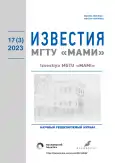Increasing the wear resistance of the ICE’s valves with the laser cladding method
- Authors: Zavitkov A.V.1, Loktev A.S.1, Lyukhter A.B.1
-
Affiliations:
- Vladimir State University named after A.G. and N.G. Stoletovs
- Issue: Vol 17, No 3 (2023)
- Pages: 217-224
- Section: Heat engines
- URL: https://journals.rcsi.science/2074-0530/article/view/249922
- DOI: https://doi.org/10.17816/2074-0530-472072
- ID: 249922
Cite item
Full Text
Abstract
BACKGROUND: There is plenty of factors leading to failure and expensive repair of piston engines at their operation. One of the widespread factors capable of affecting the engine operation is combustion chamber sealing failure. During the engine operation, gases combusting in a chamber bring pressure on working surfaces of a valve and a valve seat. If these surfaces do not ensure sealing, exhaust gases begin to leak in the exhaust manifold untimely, in some cases in the intake manifold as well. In addition, filling of cylinders with inlet charge worsens. In majority of cases, combustion chamber sealing failure caused by defect formation at working surfaces of the valve — valve seat coupling. In order to avoid combustion chamber sealing failures and other issues of operation of piston engines, it is necessary to minimize working surfaces wearing by means of wear-resistant coating.
AIMS: Wear- and corrosion-resistant coating of valve’s working surface to increase service life.
METHODS: The factors affecting the reliability of the valve — valve seat coupling were defined by means of literary sources analysis. Laser cladding at the valve’s chamfer was conducted with the laser robotized facility based on ytterbium fiber laser. Quality of the coated surface at the valve’s working chamfer was defined by means of metallographic study and liquid penetrant test.
RESULTS: After laser cladding of the PR-08Kh17N8S6G powder material at the valve’s working chamfer, the uniform coated surface with microhardness of 435–485 HV (44–48 HRC) was obtained.
CONCLUSIONS: The study results may be used for development and implementation of new kinds of wear-resistant surfaces that make it possible to increase the service life and to repair worn-down surfaces of components.
Keywords
Full Text
##article.viewOnOriginalSite##About the authors
Alexey V. Zavitkov
Vladimir State University named after A.G. and N.G. Stoletovs
Author for correspondence.
Email: vip.zavitkov@mail.ru
ORCID iD: 0000-0003-4323-5398
SPIN-code: 9599-0692
Scopus Author ID: 57214124373
ResearcherId: 4462-2022
Postgraduate of the Heat Engines and Power Plants Department
Russian Federation, VladimirAlexander S. Loktev
Vladimir State University named after A.G. and N.G. Stoletovs
Email: loktev@laser33.ru
ORCID iD: 0009-0004-5978-2219
Undergraduate of the Heat Engines and Power Plants Department
Russian Federation, VladimirAlexander B. Lyukhter
Vladimir State University named after A.G. and N.G. Stoletovs
Email: 3699137@mail.ru
ORCID iD: 0000-0003-1523-0637
SPIN-code: 5633-5549
Dr. Sci. (Tech.), Associate Professor of the Heat Engines and Power Plants Department
Russian Federation, VladimirReferences
- Kwon OG, Han MS. Failure analysis of the exhaust valve stem from a Waukesha P9390 GSI gas engine. Engineering Failure Analysis. 2004;11(3):439–447. doi: 10.1016/j.engfailanal.2003.05.015
- Panţuru M, Chicet D, Paulin C, et al. Wear aspects of internal combustion engine valves. IOP Conf. Ser.: Mater. Sci. Eng. 2016;147:012036. doi: 10.1088/1757-899X/147/1/012036
- Forsberg P, Hollman P, Jacobson S. Wear mechanism study of exhaust valve system in modern heavy duty combustion engines. Wear. 2011;271(9):2477–2484. doi: 10.1016/j.wear.2010.11.039
- Raghuwanshi NK, Pandey A, Mandloi RK. Failure analysis of internal combustion engine valves: a review. International Journal of Innovative Research in Science, Engineering and Technology. 2012;1(2):173–181.
- Dorfman MR. Thermal spray applications. Advanced Materials & Processes. 2002;160(10):66–69.
- Dorfman MR. Thermal spray basics. Advanced Materials & Processes. 2002;160(7):47–51.
- Malatesta MJ, Barber GC, Larson JM, et al. Development of a laboratory bench test to simulate seat wear of engine poppet valves. Tribology Transactions. 1993;36(4):627–632. doi: 10.1080/10402009308983204
- Forsberg P. Combustion valve wear: a tribological study of combustion valve sealing interfaces. Doctoral thesis. Uppsala; 2013.
- Cavalieri FJ, Zenklusen F, Cardona A. Determination of wear in internal combustion engine valves using the finite element method and experimental tests. Mechanism and machine theory. 2016;104:81–99. doi: 10.1016/j.mechmachtheory.2016.05.017
- Forsberg P, Debord D, Jacobson S. Quantification of combustion valve sealing interface sliding — A novel experimental technique and simulations. Tribology International. 2014;69:150–155. doi: 10.1016/j.triboint.2013.09.014
- MAHLE. Engine components and filters. Defects, their causes and prevention. Stuttgart: MAHLE. (In Russ).
- Scott CG, Riga AT, Hong H. The erosion-corrosion of nickel-base diesel engine exhaust valves. Wear. 1995;181:485–494.
- Cherevan VS. Restoration of parts by welding and surfacing. Methods, methods and processes of technical and technological development. In: Collection of articles based on the results of the International Scientific and Practical Conference. Sterlitamak 2020. Ufa: Agentstvo mezhdunarodnykh issledovaniy; 2020:102–104. (In Russ).
- Babanin AYa, Chukharkin AV. Hardening and restorative surfacing of valves of the gas distribution mechanism of internal combustion engines. Sat. scientific tr. Donbass. state tech. in-ta. Iss. 68. Alchevsk; 2021:26–31. (In Russ).
- Zavitkov AV, Pechnikov IS. Modern methods of restoring and improving the wear resistance of internal combustion engine parts. In: Actual problems of vehicle operation. Proceedings of the XXIII International Scientific and Practical Conference. Vladimir, November 18–19, 2021. Vladimir: Vladimirskiy gosudarstvennyy universitet im AG i NG Stoletovykh; 2021;111–115. (In Russ).
- Zieliński A, Smolenska H, Serbinski W, et al. Characterization of the Co-base layers obtained by laser cladding technique. Journal of Materials Processing Technology. 2005;164:958–963.
- Lyukhter AB, Palkin PA, Zavitkov AV, et al. Dependence of the structure and characteristics of a Russian alternative for AISI 304 stainless steel powder on the parameters of their laser cladding on substrates from low-carbon and structural steels. IOP Conf. Ser.: Mater. Sci. Eng. 2019;681(1):012028. doi: 10.1088/1757-899X/681/1/012028
- Palkin PA, Lyukhter AB, Zavitkov AV. Experience in developing the technology of laser cladding of powder materials. Laser, plasma research and technologies LAPLAZ-2019. V International Conference. Part 2. 2019. Moscow, February 12–15, 2019. Moscow: NIYaU “MIFI”; 2019:279–281. (In Russ).
- Gots AN, Lyukhter AB, Gusev DS, et al. Choice of modes of laser cladding of powder PR-08Kh17N8S6G. Chernye metally. 2020;11(1067):46. (In Russ). doi: 10.17580/chm.2020.11.07
- Gots AN, Gusev DS, Lukhter AB, et al. Selection of rational modes of laser powder cladding. IOP Conf. Ser.: Mater. Sci. Eng. 2020;971(2):022093.
Supplementary files












